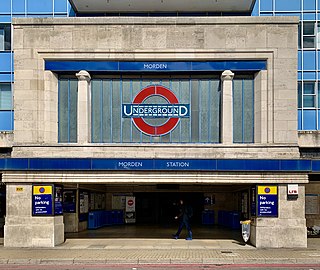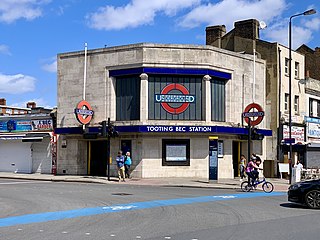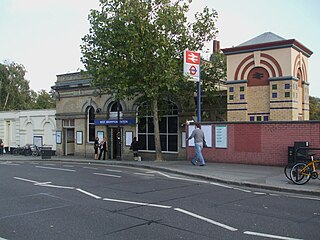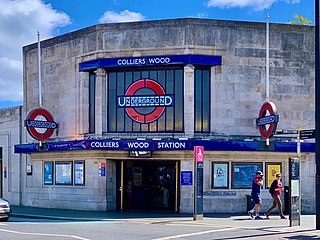
London Bridge is a central London railway terminus and connected London Underground station in Southwark, south-east London. It occupies a large area on three levels immediately south-east of London Bridge, from which it takes its name. The main line station is the oldest railway station in London fare zone 1 and one of the oldest in the world having opened in 1836. It is one of two main line termini in London to the south of the River Thames and is the fourth-busiest station in London, handling over 50 million passengers a year.

Clapham Junction is a major railway station near St John's Hill in south-west Battersea in the London Borough of Wandsworth, England, 2 miles 57 chains from London Victoria and 3 miles 74 chains from London Waterloo. Despite its name, Clapham Junction is not in Clapham, a district 1 mile (1.6 km) to the south-east.

Victoria station, also known as London Victoria, is a central London railway terminus and connected London Underground station in Victoria, in the City of Westminster, managed by Network Rail. Named after the nearby Victoria Street, the mainline station is a terminus of the Brighton Main Line to Gatwick Airport and Brighton and the Chatham Main Line to Ramsgate and Dover via Chatham. From the main lines, trains can connect to the Catford Loop Line, the Dartford Loop Line, and the Oxted line to East Grinstead and Uckfield. Southern operates most commuter and regional services to south London, Sussex and parts of east Surrey and south-east Hampshire while Southeastern operates trains to south-east London and Kent, alongside limited services operated by Thameslink. Gatwick Express trains run direct to Gatwick. The London Underground station is on the Circle and District lines between Sloane Square and St James's Park stations, and on the Victoria line between Pimlico and Green Park stations. The area around the station is an important interchange for other forms of transport: a local bus station is in the forecourt and Victoria Coach Station is nearby, which serves national and international coaches.

Richmond, also known as Richmond (London), is an interchange station in Richmond, Greater London on the Waterloo to Reading and North London lines. It is a western terminus of both the District line of the London Underground and the Mildmay line of the London Overground. South Western Railway services on the Waterloo to Reading Line are routed through Richmond, which is between North Sheen and St Margarets stations, 9 miles 57 chains (15.6 km) down the line from London Waterloo.

Moorgate is a central London railway terminus and connected London Underground station on Moorgate in the City of London. Main line railway services for Hertford, Welwyn Garden City and Stevenage are operated by Great Northern, while the Underground station is served by the Circle, Hammersmith & City, Metropolitan and Northern lines.

Old Street is an interchange station at the junction of Old Street and City Road in Central London for London Underground and National Rail services.

Morden is a London Underground station in Morden in the London Borough of Merton. It is the southern terminus of the Northern line, and is the most southerly station on the Underground network. It is located on London Road, and is in Travelcard Zone 4. Nearby are Morden Hall Park and Morden Park.

Vauxhall is a National Rail, London Underground and London Buses interchange station in central London. It is at the Vauxhall Cross road junction opposite the southern approach to Vauxhall Bridge over the River Thames in the district of Vauxhall. The mainline station is run by the South Western Railway and is the first stop on the South West Main Line from London Waterloo towards Clapham Junction and the south-west. The Underground station is on the Victoria line and the station is close to St George Wharf Pier for river services.

New Cross Gate is an interchange station between the Windrush line of the London Overground and National Rail services operated by Southern, located in New Cross, London. It is on the Brighton Main Line, 2 miles 70 chains down the line from London Bridge. It is in Travelcard Zone 2.

Kentish Town is an interchange station located in Kentish Town in the London Borough of Camden for London Underground and National Rail services.

Clapham South is a station on London Underground's Northern line between Clapham Common and Balham. The station is located at the corner of Balham Hill (A24) and Nightingale Lane, at the southern edge of Clapham Common. It is in both Travelcard Zone 2 and Travelcard Zone 3.

Wimbledon is an interchange station in the centre of Wimbledon in London for London Underground, London Trams and National Rail services, and is the only station in London that provides an interchange between the London Underground and Tramlink.

Clapham High Street is a station on the Windrush line of the London Overground, located in Clapham in the London Borough of Lambeth. It is 6 miles 21 chains (10.1 km) measured from London Bridge, the former LC&DR platforms also being 2 miles 25 chains (3.7 km) measured from London Victoria.

Kensington (Olympia) is an interchange station between the Mildmay line of the London Overground and National Rail services operated by Southern, located in Kensington, West London. Limited services on the District line of the London Underground also operate to here.

Tooting Bec, originally Trinity Road (Tooting Bec), is a London Underground station in Tooting, South London. The station is on the Northern line, between Balham and Tooting Broadway stations. It is located on the junction of Trinity Road (heading north-west), Upper Tooting Road (south-west), Balham High Road (north-east), Tooting Bec Road (south-east) and Stapleton Road (also south-east). The station is in Travelcard Zone 3.

South Wimbledon is a London Underground station in South Wimbledon, a suburb of Wimbledon in south-west London. The station is on the Northern line, situated between Colliers Wood and Morden stations. It is located on the corner of Merton High Street (A238) and Morden Road (A219). South Wimbledon is on the boundary between Travelcard Zone 3 and Zone 4.

West Brompton is a Grade II-listed interchange station located on Old Brompton Road (A3218) in West Brompton, West London. The station is served by the District line of the London Underground; the Mildmay line of the London Overground; and National Rail services operated by Southern along the West London line.

Tooting Broadway is a London Underground station in Tooting in the London Borough of Wandsworth, South London. The station is on the Northern line, between Tooting Bec and Colliers Wood stations and is in Travelcard Zone 3.

Colliers Wood is a London Underground station in South London. The station is on the Northern line, between Tooting Broadway and South Wimbledon stations. It is located at the corner of Merton High Street (A24) and Christchurch Road. The station is in Travelcard Zone 3.

Wandsworth Common railway station is in the London Borough of Wandsworth in south London. It is 4 miles 5 chains (6.5 km) down the line from London Victoria.





























